
Focusing on student success and robust technological solutions can put institutions of higher learning in a position to offer proactive — not reactive — student support. The right tools prevent data silos, track student performance, and streamline operational processes to improve workflows and create more visibility into student behavior.
Read on to learn how Watermark’s VP for Student and Customer Success, Heather Taynor, uses a 5-stage plan to improve student outcomes.
What Are the 5 Stages of Student Success?
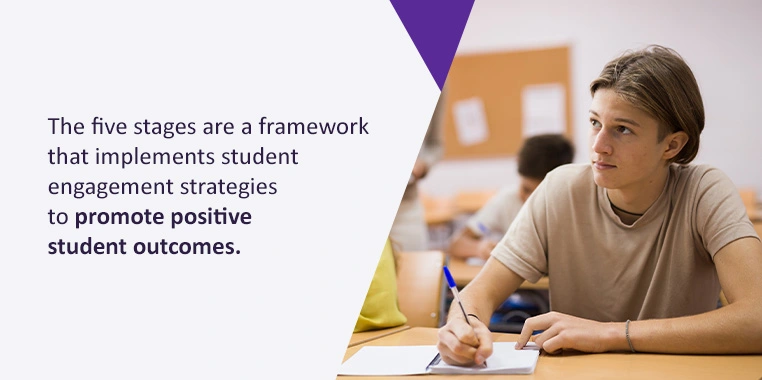
The five stages of student success help an institution guide students through the college experience. They help identify what retention strategies and interventions to provide students as they matriculate and progress towards their educational goals. The methodology is based on a solid foundation of theory, research, and practice on college student retention.
The five stages of student success are:
- Learner intake
- Early intervention
- Learner support
- Learner transition
- Actualization
These five stages represent a framework that actively implements student engagement strategies to promote positive student outcomes. Supporting students through every stage of their academic journeys is critical for overall student satisfaction and success.
Why Are the 5 Stages of Student Success Important?
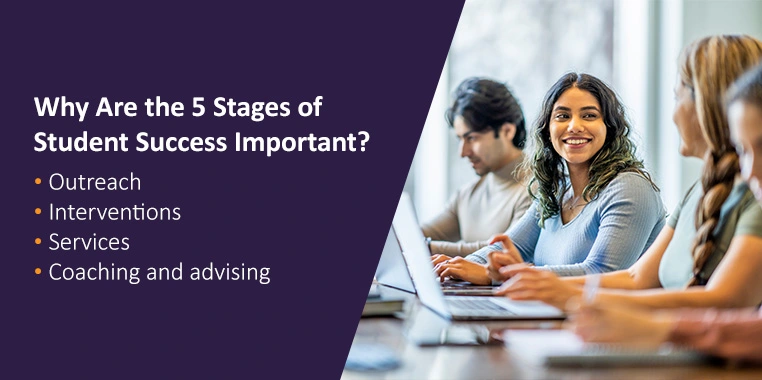
Institutions spend a great deal of energy understanding how students progress through the recruitment or admissions funnel. They must detail what type of communications should happen at different stages, what outreach is necessary and how they should be helping students. Just as admissions or recruitment has a funnel, the five stages of student success serves as a retention funnel from enrollment through the remainder of the student lifecycle.
The five stages of student success help institutions define the outreach, intervention services, retention, and student engagement strategies at each stage to help maximize student resilience and student success. Institutions define these stages by student behavior during enrollment to understand what coaching behaviors to use and how they must communicate with their students. Some areas the five stages of student success cover include:
- Outreach: The five stages help institutions provide intervention and support students. Outreach can be proactive, identifying challenges early and attempting to resolve them before they become problematic. It can also be reactive, waiting for challenges to appear in a classroom setting and handling them then.
- Interventions: Are interventions transactional, transmitting information and skills to students? Or are they transformational, promoting self-directed and motivated approaches to academic success?
- Services: Student success services can include advising, tutoring, exam reviews, and academic success coaching.
- Coaching and advising: Institutions must determine whether a prescriptive, developmental, or intrusive model is best suited to specific students. Prescriptive advising gives students a predetermined course of action based on their perceived academic abilities. Developmental advising helps students find their feet through close student-advisor relationships. Intrusive advising uses proactive institutional contact with students to develop caring relationships that lead to increased academic persistence and motivation.
The components of each stage consist of the following:
- A clear structure of each stage, from beginning to end.
- Clarity on which alerts may help identify the correct interventions for specific students and circumstances.
- How to structure communication outreach.
- Whether to consider student assessments or surveys for a particular stage.
The 5 Stages of Student Success
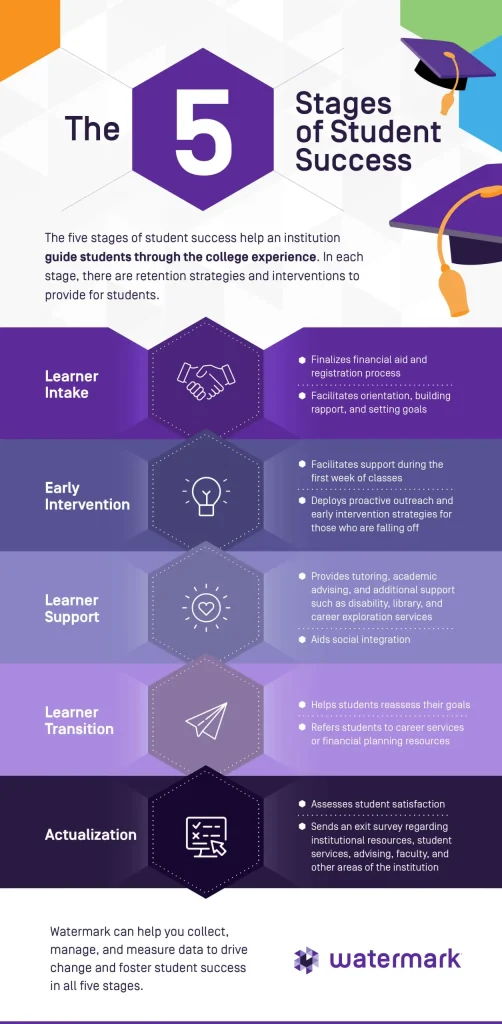
Entering institutions of higher learning can be a challenging process for students. Institutions that allow natural progression through the five stages below can help refine communication and retention strategies and increase engagement.
1. Learner Intake
The learner intake stage aims to help students enroll in the right courses, adjust to their new environment, and finalize any outstanding registration processes. Some of the focal points of this stage include the following:
- Finalizing financial aid and registration processes
- Facilitating orientation
- Completing intake assessment
- Building rapport
- Goal-setting
- Helping students before classes begin can better prepare them for their new routines at higher education institutions. It’s the first step to learning more about students and their needs and plans for college.
2. Early Intervention
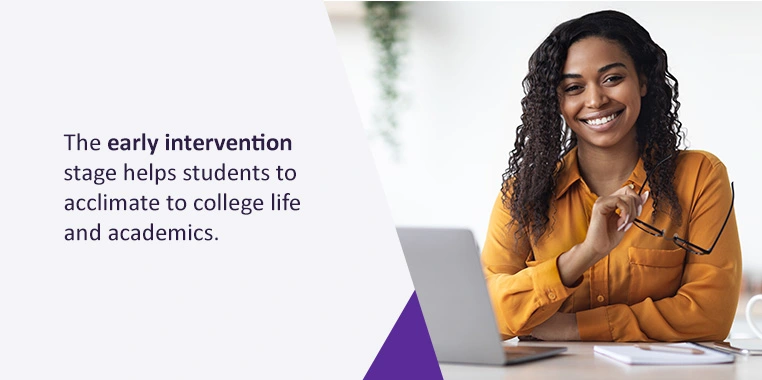
The early intervention stage helps students acclimate to college life and academics. It also encourages independent learning within their chosen course material. Some of the primary objectives throughout this phase include the following:
- Beginning proactive outreach
- Ensuring that students are set up for success
- Facilitating support during the first week of classes — helping students secure books, successfully log in to online classrooms, and know their class locations
- Deploying early intervention strategies for those who are falling off
Implementing early intervention strategies enables you to help students early in their college careers, letting you learn more about them as you develop and establish a relationship. You may discover which students may be at risk and will benefit from additional support. When you intervene early, you ensure students start on the path to success immediately during their new journey.
3. Learner Support
As students settle into a rhythm, accepting responsibility for their own skills is the logical progression in their academic journeys. This stage’s primary goal is to use student engagement strategies to support students and encourage them to accept this responsibility. The principle considerations in the learner support stage include:
- Providing instructional support and tutoring
- Academic and developmental advising
- Aiding social integration
- Providing additional support services, such as disability, library, and career exploration services
A critical part of student success is the support provided to students by their institution’s faculty. Support helps them feel capable of their tasks and requirements for school. It also lets them know they have access to help if they need it, whether it includes finding clubs to join or determining which classes work best with their schedules for the upcoming semester.
Support encourages students to persevere and accomplish their goals. Many students rely on the support they receive from others to make it through each school year, so the learner support stage is an important one that may require extra time, depending on the student.
4. Learner Transition
This stage aims to help students start to transition into their end goal, whether that be a career, completing their bachelor’s degree, or continuing to graduate school. Methods to achieve this objective include:
- Helping the student reassess their goals
- Referring students to career services or financial planning resources
Ensure a student’s success carries on into their plans after college. Interventions may occur to help students refocus on their goals and gain additional resources to achieve them. Students may meet with advisors to discuss their next steps.
5. Actualization
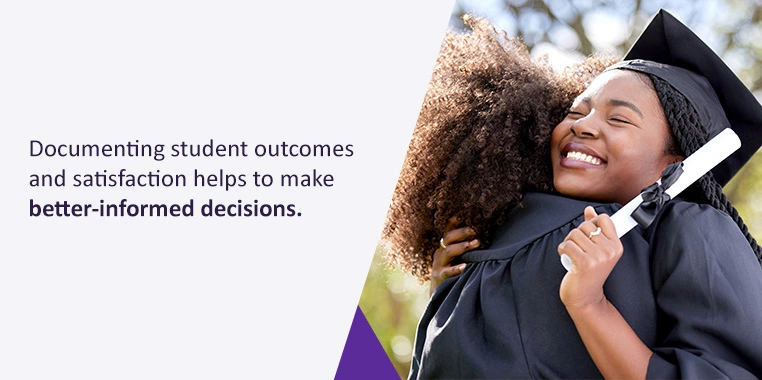
As an institution, you want to document student outcomes and satisfaction and collect as much information as possible to make better-informed decisions. This final stage aims to ensure that students have achieved their educational goals by focusing on:
- Assessing the student’s satisfaction
- Sending an exit survey regarding institutional resources, student services, advising, faculty, and other areas of the institution
Student feedback is the best way to see if your student success framework strategies have worked. Higher education institutions using this framework must track the progress of students who use the provided services to know if they’ve truly made an impact.
The Benefits of the 5 Stages of Student Success Framework
The five stages of student success is a framework for an institution to decide what type of communication, retention strategies, and services to provide throughout the student lifecycle. It’s a great way to improve your understanding of how and when you should communicate with students and how to best increase student success.
With an established student success framework, your institution can cater to students’ needs more effectively. Student success is contingent on the work your institution’s staff and faculty do to make a positive difference. Other benefits of the student success framework include:
- Improved student retention: With an advisor invested in a student’s life, they are more likely to continue their education and achieve their goals. The advisor’s job involves encouraging and assisting students in obtaining their degrees.
- Better student engagement: Students following the five stages are better equipped to participate in activities inside and outside of the classroom. When students feel supported, they are more likely to be actively engaged with their learning, volunteering, and studying.
- Increased graduation rates: Higher educational institutions typically see a higher graduation rate after implementing student success strategies. Most faculty and staff want what’s best for students, so using the approaches part of the framework could lead to more students graduating because they have support and resources that help them succeed.

Guide Your Students Toward Success With Watermark
Watermark provides institutions of higher learning with a proactive means of collecting, managing, and measuring data to drive change and foster student success. We empower colleges and higher education institutions to support meaningful data collection to enhance the student experience and garner the best possible results. Our solutions help you and your faculty stay on top of student-focused services to provide the best options for students with diverse backgrounds.
Watermark Student Success & Engagement can help keep students engaged, elevate retention, and increase the chances of successful course completion. Our AI student success and equity solution makes it easy to identify roadblocks preventing student success. Request a demo today to see how we can help you develop actionable strategies through advanced, intuitive reporting and guided pathways for students.















































































































































































































































































































































































































